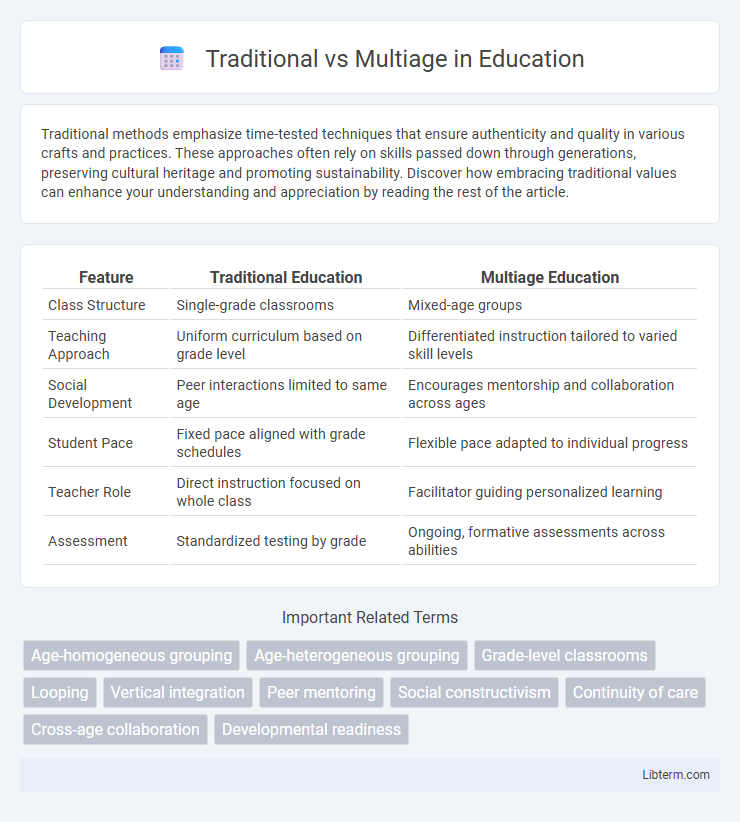Traditional methods emphasize time-tested techniques that ensure authenticity and quality in various crafts and practices. These approaches often rely on skills passed down through generations, preserving cultural heritage and promoting sustainability. Discover how embracing traditional values can enhance your understanding and appreciation by reading the rest of the article.
Table of Comparison
| Feature | Traditional Education | Multiage Education |
|---|---|---|
| Class Structure | Single-grade classrooms | Mixed-age groups |
| Teaching Approach | Uniform curriculum based on grade level | Differentiated instruction tailored to varied skill levels |
| Social Development | Peer interactions limited to same age | Encourages mentorship and collaboration across ages |
| Student Pace | Fixed pace aligned with grade schedules | Flexible pace adapted to individual progress |
| Teacher Role | Direct instruction focused on whole class | Facilitator guiding personalized learning |
| Assessment | Standardized testing by grade | Ongoing, formative assessments across abilities |
Understanding Traditional Education: Key Characteristics
Traditional education emphasizes structured, teacher-led instruction with a fixed curriculum and age-segregated classrooms that prioritize standardized testing and memorization. This model fosters discipline and sequential skill development but often limits personalized learning and peer-to-peer collaboration. Understanding its foundations is essential for comparing the benefits and challenges of alternative approaches like multiage classrooms.
Defining Multiage Classrooms: An Overview
Multiage classrooms group students of different ages and grade levels together, fostering peer learning and collaboration while addressing individual developmental needs. Unlike traditional classrooms organized by strict age-based grades, multiage settings promote flexible pacing and personalized instruction. Research shows multiage environments can enhance social skills, academic achievement, and student engagement by creating a diverse and inclusive learning experience.
Historical Context: Evolution of Classroom Structures
Traditional classrooms, rooted in 19th-century industrial models, emphasize age-segregated groups following standardized curricula to streamline instruction and assessment. Multiage classrooms emerged in the late 20th century, inspired by progressive education theories from John Dewey and Maria Montessori, promoting mixed-age groups to foster peer learning and social development. This evolution reflects a shift from rigid age-based teaching structures to more flexible, student-centered learning environments.
Core Principles of Traditional Classrooms
Traditional classrooms emphasize structured, age-segregated learning environments where curriculum follows a fixed sequence, and teacher-led instruction dominates. Core principles include standardized assessments, clear behavioral expectations, and a focus on rote memorization and mastery of discrete subjects. This model prioritizes uniformity and control to ensure predictable academic outcomes across all students.
Foundational Elements of Multiage Education
Multiage education centers on foundational elements such as flexible grouping, allowing students of different ages to learn together based on ability rather than grade level, fostering peer learning and collaboration. This approach emphasizes individualized instruction tailored to diverse developmental stages and promotes a supportive community that nurtures social-emotional growth. Unlike traditional education's rigid age-based cohorts, multiage classrooms adapt to student needs, encouraging continuity and depth in learning experiences.
Academic Outcomes: Comparing Student Achievement
Traditional classrooms often group students by age, leading to uniform curriculum pacing and standardized assessments that target age-specific benchmarks. Multiage classrooms blend different grade levels, encouraging peer learning and individualized instruction, which research shows can enhance critical thinking and social-emotional skills, contributing to improved academic outcomes. Studies indicate multiage settings frequently result in higher student engagement, greater retention of material, and comparable or better standardized test performance compared to traditional age-segregated classrooms.
Social and Emotional Development in Both Settings
Traditional classrooms often emphasize age-specific social interactions that support normative developmental milestones, fostering peer relationships within a narrow age range. Multiage settings enhance social and emotional development by promoting mixed-age collaboration, empathy, leadership, and adaptability through sustained peer mentoring and diverse group dynamics. Research indicates that multiage environments contribute to improved self-esteem and social competence by encouraging inclusive communication and emotional regulation across varying maturity levels.
Teacher Roles and Instructional Approaches
Traditional classrooms emphasize teacher-centered instruction where educators primarily deliver content through direct lectures and structured activities, focusing on standardized curriculum goals. Multiage classrooms adopt a facilitative teacher role, promoting individualized learning, collaboration, and peer mentoring across different age groups to foster social and cognitive development. Instructional approaches in multiage settings prioritize differentiated teaching strategies and flexible pacing, contrasting with the uniform, grade-level progression typical of traditional models.
Parental and Community Involvement
Traditional education often involves structured parental engagement through scheduled parent-teacher conferences and standardized volunteering opportunities, fostering a predictable community connection. Multiage classrooms encourage continuous parental participation by promoting collaborative projects and flexible communication, enhancing deeper parental insight into child development. Community involvement in multiage settings typically expands beyond the school, integrating local resources and diverse generational interactions to support holistic education.
Choosing the Right Model: Factors to Consider
Choosing between traditional and multiage classroom models depends on factors such as student diversity, learning pace, and instructional flexibility. Traditional classrooms group students by age, which suits standardized curricula and age-specific assessments, while multiage models promote mixed-age collaboration and personalized learning trajectories. Educators must assess school resources, teacher expertise, and community support to determine the best fit for student engagement and academic growth.
Traditional Infographic

 libterm.com
libterm.com